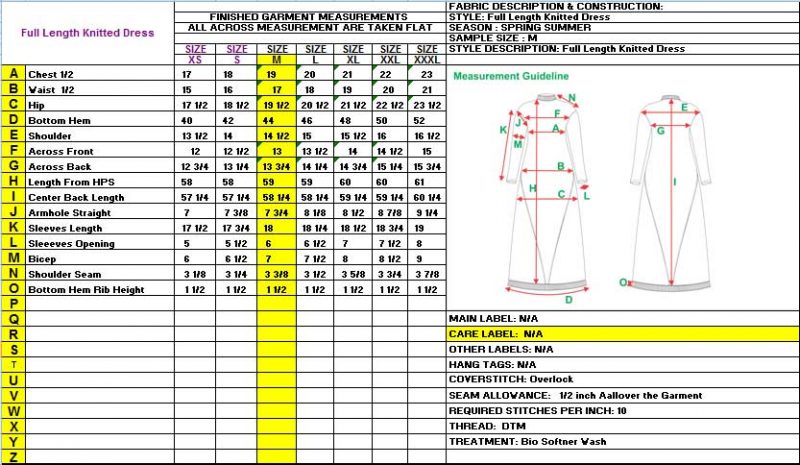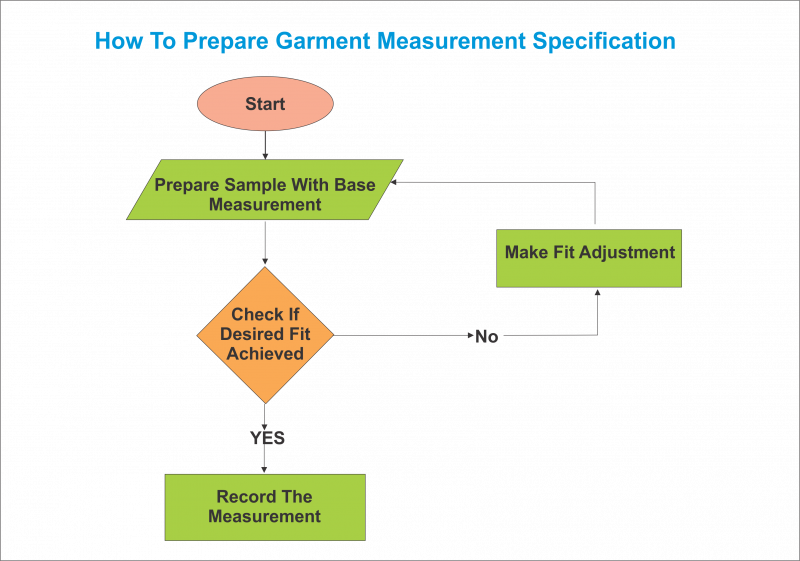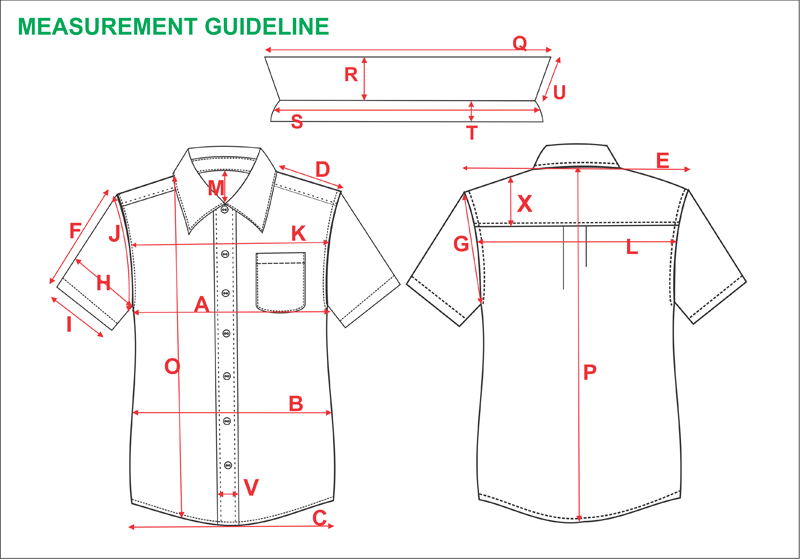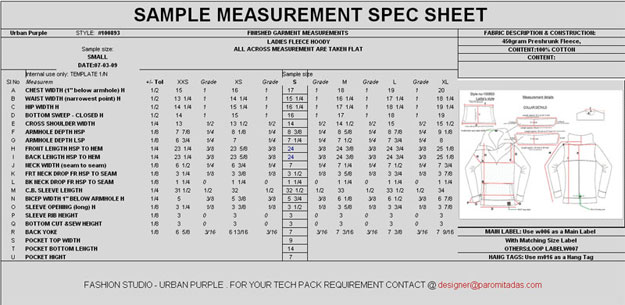Garment Measurement Specification – Base of Garment Fit Technique
Garment Measurement Specification is essential in fashion design, pattern making, and production. Apparel product development is a complex chronological process that starts with tech pack design. Tech pack design is a systematic process that includes garment size specifications. And this process is the backbone of getting a perfect fit sample for a style. In this post, we will discuss the preparation of the measurement spec sheet in detail and try to go deep into it. Here, we discuss fashion measurement standards, their contents, and preparation. As a tech pack designer, I will try to make it as simple as possible. Are you looking for ready-to-use fashion tech packs? Visit our tech pack template store. If you have more doubts, please ask questions in the comment section. I will answer your queries and try to answer them as clearly as possible.
What are garment fit specifications?
Precision is the foundation of every garment pattern we create. Our garment pattern-making service division initiates the meticulous pattern-making process. Usually, pattern masters refer to both fashion sketches and the garment measurement spec sheet. So, the spec sheet is the essential document for preparing garment patterns. It’s a comprehensive blueprint with measurements and guidelines for pattern-making. Whether you prepare a paper pattern or digital CAD pattern design, a garment size chart is essential.
Take a look at the sample Garment Measurement Spec Sheet below. On the left side, you’ll notice labels A, B, C, and D in the first column, each corresponding to markers on the color-coded guideline. The double-arrow lines indicate the precise start and end points for measuring. In the second column, you’ll find detailed names and explanations for each measurement point. Each row beyond that presents the measurements for various sizes, be it XS, S, M, L, and more. This meticulous approach guarantees accurate, consistent patterns tailored to your specific sizing needs.
Garment measurement specifications are a systematic table that presents measurements of a style. They enable the pattern master to refer to measurements of critical points of a style to prepare a pattern. The measurement guideline attached to the spec sheet is a visual pointer. Garment measurement guidelines help us understand how to take sample measurements and compare them with the spec sheet.
There are no specific definite numbers in a measurement. The measurement spec sheet for different brands differs. Every brand targets its customers differently; some target the masses, some focus on people with well-built bodies, some concentrate on bulky people, etc. You will find the difference when comparing two different brand standard size specs. In short, every brand wants to prepare its version of the measurement spec sheet. So, they prepare their custom measurement spec sheet.
Preparing Garment Measurement Specification Sheet
Most apparel brands try to get the spec sheet by copying other famous brands. However, some brands make their own according to their specific needs. If you are sourcing the measurement from different brands, it’s the easy way. You must invest in developing spec sheets if you are dealing with custom clothing. For custom clothing design, preparing the fit measurement is a trial & error process. The process starts with a sample development to check the fit. The designer, fit technician, and pattern maker adjust until the sample achieves the desired fit. Record the revised measurements and prepare the base size if the fit is right. If you fail to achieve it, then check where the error is and rectify it. This process keeps repeating till you get the desired fit.
The above process repeats until you get 100% fit of the garment style. It is time-consuming and expensive, but once you have the correct measurement specification, you can use it forever.
Grading for Different Sizes
Technical designers and fit technicians record the base measurement by considering a specific size (e.g., size—M). It is the sample size, and manufacturers try to achieve the perfect for the sample size. Once clothing manufacturers get the ideal fit, they start grading it from a full range of sizes. The sizes could be XS, S, M, L, XL, and XXL. Once you get the desired base measurement, the next step is grading. Grading is the process of achieving measurements of different sizes for a style.
Point of Measurements:
So far, we have discussed how to get the measurements using the trial-and-error method. Now that we have a correct base measurement, we can prepare the detailed measurements. Few measurements are less significant but play a vital role in the fit and look of a garment. Armhole curve, shoulder seam, and front neck drop are examples. Many pattern masters and technical designers ignore those measurement points, but they are essential in achieving a desired fit.
When we prepare a detailed spec sheet, we get base measurements from body data. We derive other measurements by using specific calculations. Here, we follow simple geometric rules to derive particular data. Also, a few formulas are applied to derive specific measurements. You don’t need any heavy software to prepare garment measurement spec sheets. You can prepare the spec sheet even by hand or using Microsoft Excel. The garment spec sheet should permanently be attached to the apparel tech pack.
Tolerance:
Hundreds of factors can cause variations in garment measurement, such as sewing and garment construction, minor errors in cutting, and so on. So, the technical designer should consider those variations in the spec sheet. Maintaining some tolerance to cover the mistakes that may occur during processing is essential. For example, when giving body measurements, the chest, waist, or bottom should have +/- 1/2″. In comparison, small parts of the garment should have relatively more minor tolerance. It is up to the tech pack designer to give tolerance that can cover a variation during production.
Measuring garments as per size specs is a critical aspect of quality control. Quality garment exporters keep QCs who can check the fit. During bulk production, it is impossible to have all the garments identical. So, in garment specs, designers set a tolerance for each measurement point. Tolerance is the safety net for a small margin for error that may occur during bulk production, which is acceptable during bulk production. When we prepare the spec sheet, we must keep a certain acceptable margin. The technical designer should consider the tolerance needed when creating a spec sheet. Tolerance is often expressed as (+ / -) in the spec sheet with an acceptable amount.
Importance of Garment Measurement Specification In Apparel Design and Production
Apparel brands need detailed garment size specifications to make correct patterns and samples. Get ready with a tech pack and spec sheet of your styles before speaking to a clothing manufacturer. If your size charts are accurate, your pattern design and sample development can save much money. Online stores offer base-size guides to help customers find the best fit for their body type. I have written a detailed article about garment measurement specification components to help you better understand what they are and how they work.
The Civil War was pivotal in the historical development of men’s ready-made clothing. During the Civil War, the military used workers to sew custom-made uniforms at home under government contracts. As the war continued, manufacturers started to build factories that could quickly meet the demand for military clothing. Factories feel the need to develop standard sizes for mass production of uniforms. They found that certain sets of measurements of the soldiers repeat with conventional regularity. Consequently, after the war, factories used military measurements as the standard measurement for commercial use.
Ready-made clothing rarely fits due to a lack of consistency in garment measurement specifications. So, get the help of a tech pack designer to get the measurement specifications for your style. Most manufacturers follow a unique random sizing system based on erroneous body data. So, you find outfits of different measurements were often labeled the same size. As a result, you end up paying some extra as a return charge. You must keep standard measurements constant even if you change styles.
Why Choose Fashion Studio Urban Purple?
Fashion startups struggle to find a proper tech pack designer who can take their design ideas to the next level. The talent hunt becomes difficult as every tech pack service provider promises the same. It is always good to research before choosing a vendor for your tech pack development. Refer to blogs like Clothing Tech Pack Design, where you may have basic info about tech pack design. Our tech pack designer helped more than a hundred clothing brands grow over a decade of experience. We have experience working with brands with cultural and geographical divergence. Our tech pack design service helps you convert your style ideas into salable garments. We worked with many creative ideas and incorporated them into fashion styling. We treat up-and-coming brands and big brands with multi-stores in the same way.
Our priority is to respect every brand’s reputation and business ethics. We love our clients and support you to see you meet your goals. Let us know if you seek support for your line’s design and manufacturing. Please send us your sketches or ideas for our consultation about the clothing line. Once we have your design concept, our tech pack designer will guide you. If you fall short of time and are looking for ready tech packs, check out our pre-tested garment tech packs. You can get tech packs from our tech pack template store.
As a personal blogger, I rely on the support of my readers to help spread the word about my content. Found this valuable? Please spread the word by sharing it with your network! With your help promoting my blog, I can continue creating helpful content for my readers. If you’re interested in a particular apparel design and manufacture, please do not hesitate to let me know. You can show your support by following me on Instagram.
You may also like to see
- Measurement Specification Guideline – How to Spec a Garment
- Garment Measurement Specification – Garment Fit Basics
- Difference Between Specification Sheet and Tech Pack
- Spec Sheet Components With Measurement Guideline
- Preparing Garment Measurement Specification Sheet – Clothing Designer
- How to Prepare Garment Measurement Spec Sheet



